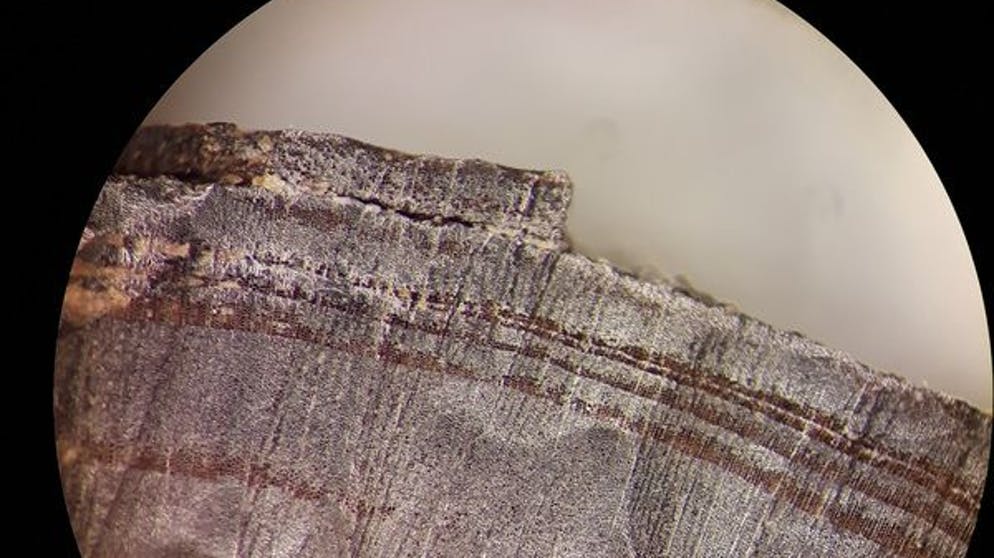Photo: Glenn Nagel Photography/Springer Nature/DPA
It is known that the Vikings were in America long before Columbus. Now researchers have determined the exact year in which the northerners settled in Newfoundland. A solar storm over a thousand years ago helped them do just that.
Exactly a thousand years ago, in 1021, it was already possible Vikings Lived in North America. At least that’s what a team of researchers has suggested analyzing the woody remains Presented in “Nature” magazine. Thus these discoveries are the oldest accurately dated evidence that people came to America from Europe. A violent solar storm helped the team determine the age of the logs.
who – which Columbus He was not the first European to reach the American continent and has been known for some time. Last but not least, the Sagas, the old Norse stories from the Middle Ages, describe in relative detail how the Vikings sailed across the Atlantic with their famous tall ships hundreds of years ago.

Photo: Petra Doeve/Springer Nature/dpa
micro dating
But these stories, initially transmitted orally, have long been dismissed as legends and fairy tales – also because they contain many paradoxical and fantastic elements. It wasn’t until the discovery of the archaeological site of L’Anse aux Meadows in 1961 on the northern tip of the Canadian island of Newfoundland that the epics became historical sources. The exact age of the settlement has not yet been established, nor the exact time of the arrival of the Vikings on the continent.
Three discreet pieces of wood just found at L’Anse aux Meadows now seem to allow a more accurate dating. The remains, which come from different trees, were closely examined by a team led by geoscientists Michael D and Margot Koetms of the University of Groningen. Scientists are sure that wooden artifacts could be assigned to sailors in Northern Europe – not only because of their location, but also because they clearly showed signs of processing from blades made of metal, a material that the locals did not make at the time.
clear signal
In clarifying the question of when the artifact wood was obtained, scientists have now helped establish radiocarbon dates as well as a cosmic event: In AD 992, a massive solar storm occurred, resulting in a clear radiocarbon signal in the tree. episodes in the following years.
“The apparent increase in radiocarbon production between AD 992 and 993 was observed in tree ring archives around the world,” Research Director Dee explains in a press release. This signal was displayed in each of the three woody objects examined in 29 growth rings in front of the phloem edge. “The fact that we found the solar storm signal 29 growth rings in front of the phloem allows us to conclude that the cutting activity occurred in AD 1021,” summarizes lead author Kuitems.
Their analysis thus sets a new benchmark for the arrival of Europeans on the American continent, according to the authors. In addition, it emphasizes the potential value of cosmic radiation events – such as the powerful solar storm here – as reference points for the future dating of artifacts and environmental events.
The effects of the Vikings are not clear
It remains unclear how many expeditions the Vikings made to America and how long they stayed there. Neither of them is yet known about the effects of their stay.
Icelandic epics suggested that the Vikings entered into a cultural exchange with the indigenous peoples of North America, as the researchers wrote: “If these encounters did indeed occur, they could have had unintended consequences, such as transmission of pathogens, the introduction of aliens to animal and plant species, or even the exchange of human genetic information “.
However, recent data from North Greenlanders have shown no evidence of the latter. The authors conclude: “How the year 1021 CE relates to the transatlantic activities of the Vikings as a whole is the subject of future research. However, our results provide a temporal anchor for further investigation of the consequences of their expansion into the Far West.”
https://www.nature.com/articles/s41586-021-03972-8
SDA / dpa / uri

“Tv specialist. Friendly web geek. Food scholar. Extreme coffee junkie.”







More Stories
Before the 2024 European elections – a political earthquake in Sweden due to the Trollfabrik scandal – news
For a study in Brazil: The researcher encountered poisonous snakes 40,000 times
Airbus A340-300: will the former German government aircraft 16+02 take off again?